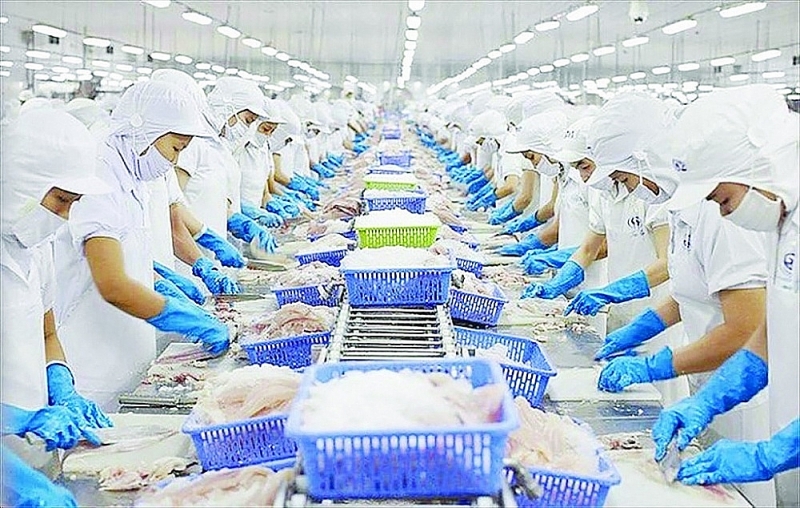Seafood export enterprises navigate through "storms"
After peaking at 11 billion USD in 2022, seafood exports in 2023 encountered numerous challenges, only achieving about 9 billion USD. Amidst market and raw material processing difficulties, seafood export enterprises exerted significant efforts to weather the "storm".
 |
|
Seafood export enterprises have broadened their scope.Photo: S.T |
Maximizing Each Order
Mr. Truong Huu Thong, Director of Thong Thuan Company Limited, while exporting a shrimp consignment to the European market at the year's end, reflected that 2023 was particularly challenging for seafood businesses. They faced a declining global economy, especially in key markets like Europe, Japan, and the US, which together constitute over 90% of the company's market share. In 2023, the company's export orders decreased by more than 20% compared to 2022. Nevertheless, the company strove to maximize each order to maintain employment for its workers.
Mr. Ho Quoc Luc, Chairman of the Board of Directors of Sao Ta Foods Joint Stock Company, a large shrimp exporting enterprise in the Mekong Delta, noted that the current volume of marketable shrimp is low. Processing companies are receiving only half the usual daily amount of shrimp raw material. This is attributed to a reduction in orders. Vietnamese companies' sparse orders are often perceived as overpriced by 1-2 USD/kg compared to other countries' offerings. “Even at these prices, companies are not profiting, sometimes even incurring slight losses, but they continue to produce, retain orders, and provide some employment for workers to earn a living," Mr. Luc emphasized. Sao Ta Foods Joint Stock Company has accordingly adjusted its 2023 revenue target to 4.870 trillion VND and pre-tax profit to 300 billion VND, marking a 17% and 25% decrease, respectively, from the initial plan. This profit target is also 6% lower than the previous year's.
Vin Hoan Corporation, a leader in catfish exports, reported a substantial decline in catfish exports in 2023, including in traditional markets. Ms. Truong Thi Le Khanh, Chairwoman of the Board of Directors, highlighted that catfish exporting enterprises have expanded to over 140 countries. However, she noted the catfish processing industry's heavy reliance on unskilled labor as a future challenge. Adopting machinery and technology in production to reduce labor-intensive processes is a strategic solution. The industry needs to invest in technology to meet increasing environmental and social security standards. Flexible mechanisms and state commitment are essential to boost enterprises in implementing deep-processing export development programs.
All enterprises agree that in 2023, selling prices have fallen to a minimum, and despite increased revenue, profits are minimal. The abrupt reduction in export orders at the end of 2022, extending into 2023, has posed significant challenges for businesses, necessitating market reorientation and maximizing every order to sustain export production.
Enhancing processed products
Achieving the 2023 business targets has become a common challenge for many exporting companies amid declining export orders. Many have had to adjust their revenue, reorient exports, restructure the market, and notably increase value-added products.
According to Vin Hoan Corporation's leadership, the company's key export product is frozen catfish fillets, contributing over half of the company's 2023 revenue from processed farmed fish products. The company increasingly relies on revenue from value-added products, collagen, gelatin, and processing salmon for its Japanese partners. When the market is subdued, value-added products tend to be less impacted by supply and demand fluctuations. Vin Hoan Corporation produces not only breaded catfish fillets but also diversifies with various products, including seafood noodles and vegetable dishes.
For shrimp, a primary export commodity, Mr. Ho Quoc Luc noted that shrimp exports have exceeded 4 billion USD, ranking among the top 10 high-revenue export products known for advanced processing capabilities and expansion potential. However, the Vietnamese shrimp industry is grappling with continuous and complex challenges. The foremost issue is the low success rate in farming, leading to high costs. Additionally, frequent diseases in farmed shrimp reduce productivity and size at harvest. A lack of capital for production among most farmers further exacerbates the situation. These challenges are expected to persist and intensify through 2024, highlighting the urgency of immediate adaptive strategies.
Mr. Truong Huu Thong shared that Thong Thuan Company Limited has innovated sales methods, optimized costs, and explored cost-effective shrimp farming techniques. Companies must be adaptable, assessing market realities to devise coping strategies. The company has maintained stable production and workforce by transitioning to value-added products such as sushi, battered, and tempura.
Mr. Doan Van Dong, Director of Can Tho Seafood Import-Export Company Limited, anticipates that the challenging landscape of 2023 may extend into 2024. As a result, companies must proactively devise survival strategies, identify and confront the array of challenges and specific situations to navigate through them. In a shift from earlier expansion strategies, companies are now focusing on optimizing their existing product lines, enhancing quality, and improving production efficiency. Given the near saturation of Vietnam’s value-added shrimp products in the market, companies are advised to concentrate on refining the quality, packaging, and design of their existing products, rather than seeking new markets or customers. Retaining current, loyal customers, upgrading equipment, modernizing facilities, caring for the workforce, and enhancing wages to retain skilled labor are vital for ensuring stable employment, skill advancement, and stabilizing production to weather this challenging period.
Despite facing a multitude of challenges and obstacles, along with the support from regulatory bodies in trade promotion, easing capital and procedural constraints, etc., seafood companies have strived to surmount a difficult year, successfully earning more than 9 billion USD from their export endeavors.








